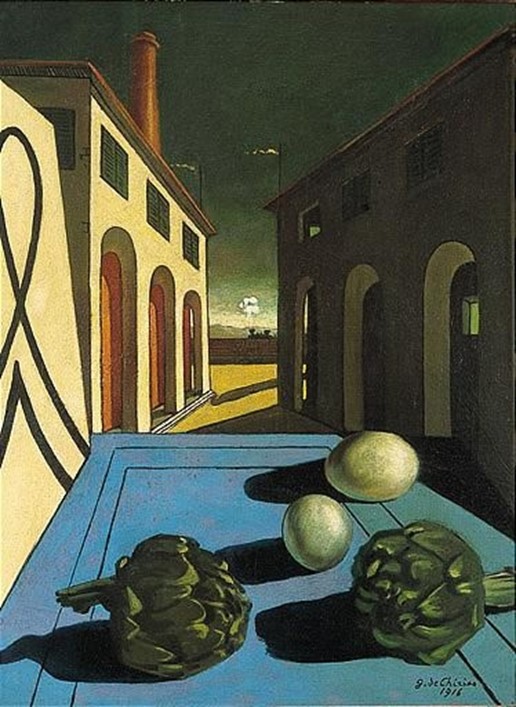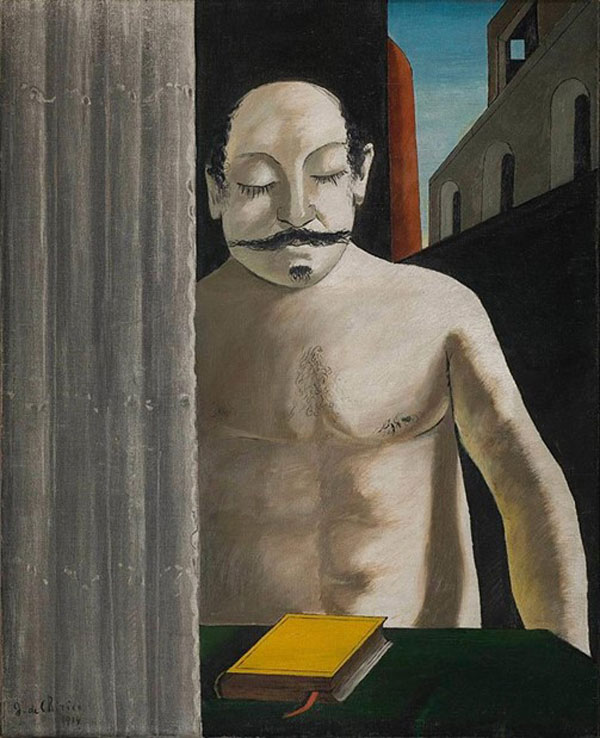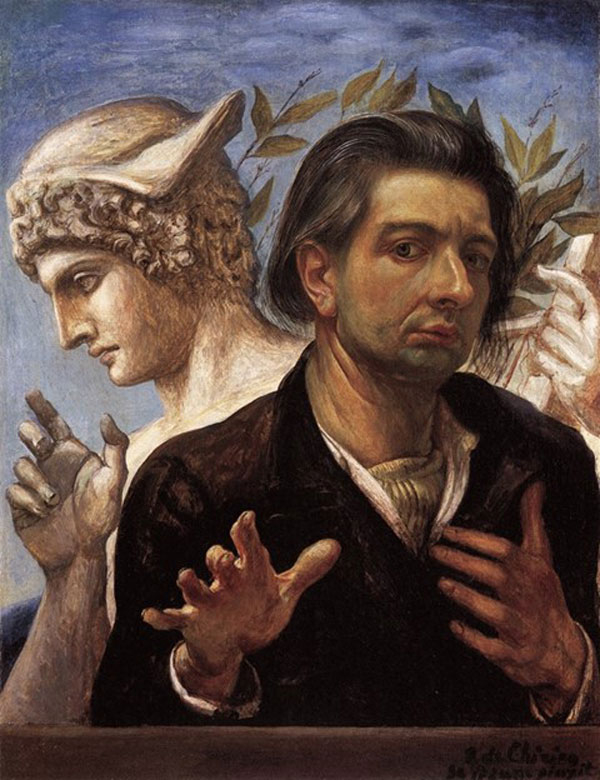|

Giorgio de Chirico, The Enigma of Departure, 1916
Is there something in the nature of de Chirico's work itself that frustrates
all articulate interpretation? I would argue that there is. The images do
confront us with inscrutable demands. Is the omnipresent sense of paradox
a barrier to understanding or the key to the work's power, its potential to
fascinate and obsess? I will explore these issues more abstractly in a
moment. First, let me speak to how a system of obscure signs can activate
the intuition and enter directly into the bloodstream of the unsuspecting
viewer.
At the age of 16, I discovered the work of de Chirico—with a shock. It was
not like leafing through the work of other artists, Van Gogh or Gauguin, for
example, who had earlier transfixed me. It was instead more like
discovering a new world, or being altered by a drug, which had the power
to rearrange my entire way of seeing. I was possessed by an experience that
was not my own. On the edge of sleep, all the objects in my room would
transform themselves into objects painted by de Chirico, as the breath of
the artist leaked in through the windows. My emotions were those of
someone who had lived through the First World War. The present moment
was as tangled as the rigging of the Sargasso.
As in a previous world, the deaths of millions struck us as a pointless
aesthetic game, whose absurdity only the deepest insight could transmute.
The Infinite had left its thumbprint on our foreheads. I could not do much
of anything, and yet, like the young de Chirico, I was convinced that I was a
genius. The light by which I saw was not thrown by my lamp. Should my
mother pause at the door, a plate of sardines in her hand, she would
instantly be changed into a manikin. My heart would pound. I would jump
out of bed, ready, almost, to scream. Dead gods would hold a convention
on my tongue. The room would spin. Whatever your interpretation, and
against appearances, I was very clear and sober, and I would watch in
horrified fascination as my childhood grew strange.
At first, I had assumed that my encounter with de Chirico and his work was
a one-of-a-kind event. I would soon discover that my experience—my
"revelation," if you will—fit the classic pattern. Other lives had been
changed. Max Ernst, for example, writes, "I thought I was seeing something
long familiar again, as though something I had always known revealed a
whole region of my dream world, which, by interposing a kind of
censorship, one had prevented oneself from seeing and understanding."
Similarly, in 1922, upon his return to Paris from four years of military
service in Tunisia, Yves Tanguy spotted a reproduction of "The Child's
Brain" in a shop window and jumped from his streetcar to examine it more
closely. This was the beginning of his career as a painter. Like those before
me, I too had stepped onto a stage-set that was not quite that of a painting;
no, these paintings were a means of gaining access to a world, a world that
was mysteriously as much mine as de Chirico's.

Giorgio de Chirico, The Child's Brain, 1914
The symbols that called to me with such urgency were indeed nonsensical,
exactly as de Chirico had claimed; at the same time, they did make
inscrutable demands, demands that came with an implied threat. These
were offers that their recipient was not free to refuse. One's halfway
articulate response could be postponed, perhaps even for some period of
years, but it could not be avoided altogether. And presiding above this stage
-set was a presence, whose language these symbols were, a presence that I
naïvely assumed to be that of the artist.
I began to notice something peculiar, however. In many of de Chirico's self
-portraits, he portrays himself as one half of a dyad. In his "Self-Portrait
with Portrait Bust," for example, the artist's eyes are angled a bit
downward. He looks uneasy, as if unwilling to directly confront the eyes of
the viewer. Meanwhile, a stone bust of the artist, turned sideways, stares
directly at him with blank eyes. And in "Self-Portrait with White Shadow,"
the artist looks at the viewer as if he were carrying the weight of the world
on his shoulders. Behind him, a ghostly figure with his profile turns away
to coldly gaze out of a window. This figure seems to be emerging from his
back, and it is not at all clear whether we should see it as a statue or as
ectoplasm.
Who was this second figure, I wondered, and was it he and not de Chirico
himself who had so decentered my psyche? Even then, I could sense that
the artist was the physical vehicle for some presence, a presence whose
language he had faithfully transcribed but had only partially managed to
translate and interpret. I came to believe that presence that had also sought
me out.
***

Giorgio de Chirico, Self-Portrait with Bust of Mercury, 1923
Chance liberates the mute connection between objects, thus articulating the
agenda of a multidimensional labyrinth. Beyond good or evil, the One as
imagined by Parmenides coheres, as a sphere that cannot be broken. The
desire of each individual object is obscure. A gulf separates the One and the
Two.
Hieroglyphs wear as camouflage the whole length and breadth of history. A
rubber glove is looking for its hand. The past stores energy for future use,
even when no action is apparent in the present, beyond that of the wind.
Pain rises like a seismic shock wave through the feet, as a not yet declared
war provokes an intestinal revolution. The auras expanding around each
object speak of an Opus Contra Naturam, a "great work against nature," of
a cold sun, pulsing without love. As he himself had been instructed, the
artist instructs us to greet the fears of the living with detachment. Always, it
is time to go.
In a letter from 1913, de Chirico wrote,
One of the strangest and deepest sensations that prehistory has left
with us is the sensation of foretelling. It will always exist. It is like an
eternal proof of the senselessness of the universe. The first man must
have seen auguries everywhere; he must have trembled at each step he
took.(6)
In de Chirico's work, something is always just about to happen. Behind a
wall, a ship is waiting to depart. Only the sail is visible. We infer that the
ship, like the ocean that rocks it back and forth, is there. A locomotive
whistles in the distance, appearing to speed. A puff of smoke from its stack
is frozen in mid-air. There are towers and arcades. Freud might say that
these were sexual symbols. There are the instruments of an architect,
cannon balls next to a cannon, a spool of Ariadne's thread that has been
abandoned by a factory, the map of a distant coast, a clock whose hands
have frozen at six minutes before three, a big bunch of bananas, a plaster of
Paris foot, and children's toys. Signs point in opposite directions, leading
us, after great exertions, back to where we started.
Perspectives collide. There are multiple vanishing points. Of the six to be
found in "The Melancholy of Departure,"for example, not even one is
correct. Every element looks as clear as one of the principles of Newton. It
is only the result that is contradictory. The lines are exact, but the space
does not add up. Similarly, the clock on the brick tower tells us that it is 25
minutes past one, while the length of the shadows tells us that the clock
cannot be trusted. In this as in many other pictures, the lines of perspective
point towards the depths of an infinite sky. The horizon intoxicates, yet it is
oddly difficult to move from our position in the foreground. And if, in a few
hours, we find that the scene that we are looking at has changed, then it
may not be at all clear how we have travelled from one spot to another. No,
when our eyes again refocus, we may find that we have wandered into "The
Enigma of the Day," with no recollection of our having ever moved. The
scene is different. The spell has not been broken.

Giorgio de Chirico, The Enigma of the Day, 1914
Transformed by Medusa into stone, in revenge, perhaps, or as punishment
for hubris, the statue of a patriarch still dominates the square. He can only
dream of sleep. He has not halted his investigations, and he stares one
-pointedly in our direction as we pass. There is, no doubt, a spirit trapped
inside this statue, or a god, who would appear to expect some service on
our part—at some point soon to be specified—which might eventually lead
to its release. It sometimes seems that the dead change places with the
living, without either knowing that a change has taken place. Shadows
become more important than the objects that project them. The unseen is
more powerful than the seen.
Thomas Mical writes,
The enigmas of de Chirico's architectural representations posit
repetitively the end of history as a disappearance into the unknowable
vanishing point of the absolute past. The origin and the end repetitively
achieve unity, make the thought of the eternal recurrence into a series
of fragmentary spaces disturbingly outside linear temporality.(8)
There is no way through or out of the beyond. Let us say that we ask a
question, a pregnant one; it is some stranger who will hear the almost
irrelevant answer. Like a radio signal, close at hand but inaudible to those
not tuned to the station, there is also a larger presence that inhabits the
somewhat greenish atmosphere, where to his own ends he manipulates
events. By what antediluvian technology does this guardian curve time and
space, so that, at the end of a long voyage, we find ourselves in the same
autumnal square, facing the enigma, wrestling with a shadow that does not
permit us to escape?
The dream turns on itself. It has no beginning, and will have no end. Mark
C. Taylor writes, "The origin of that which has no origin is the origin of the
work of art." (8) The exit from and entrance to the labyrinth are the same,
but a figure eight is a more complex closed curve than a circle. It goes
down to go up and up to go down, out to go in and in to go out. When the
curve of the infinite intersects with the world, its movement is defined by a
peculiar repetition. We have seen this curve before. It manifests. It finds its
corresponding image, yet the second curve is not an exact reproduction of
the first. Friction is produced, causing a spark to jump into the artist's
mind. The curves meet in a point that does not have a location.
***
Notes
6) Giorgio de Chirico, Manuscript from the Collection of Paul Eluard, from
"Appendix A" of James Thrall Soby's Giorgio de Chirico, page 248
7) Thomas Mical, The Eternal Recurrence of "l'effroyablement ancien,"
1998, http://www.pd.org/topos/perforations/perf20/mical.pdf, page 6
8) Marc C.Taylor, Altarity, University of Chicago Press, 1987, p. 246
|